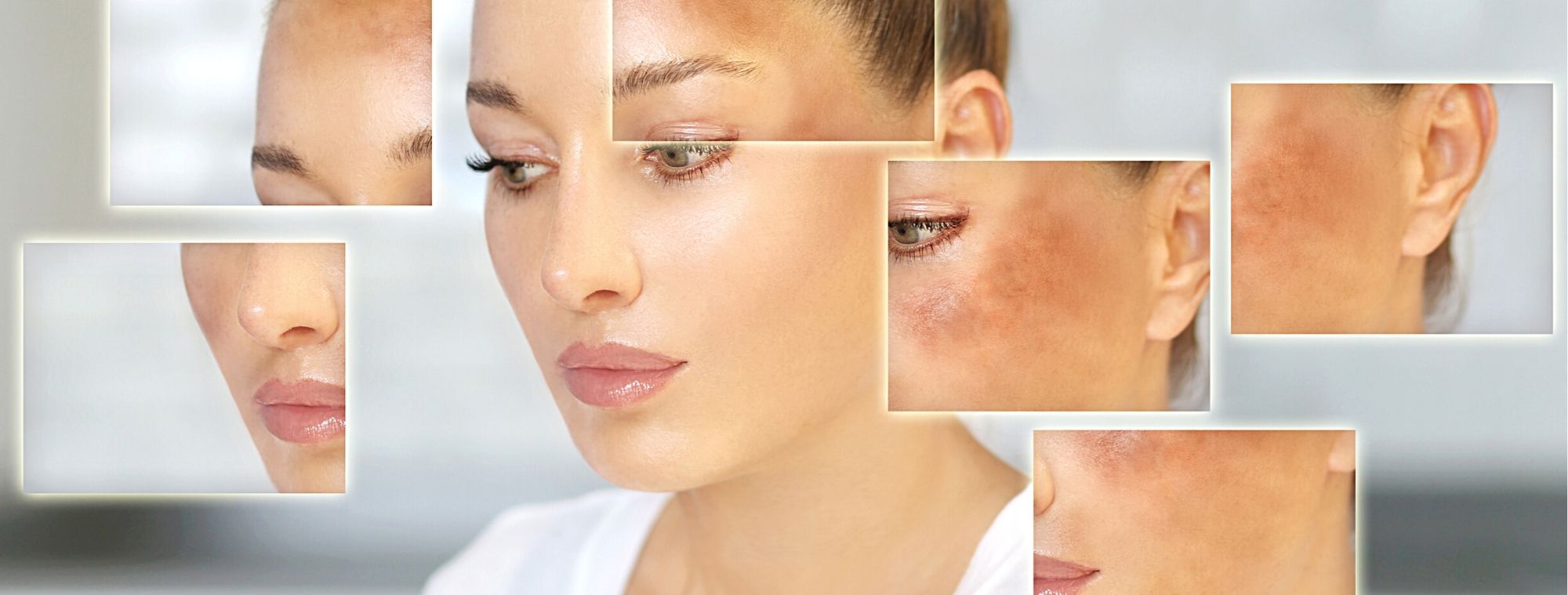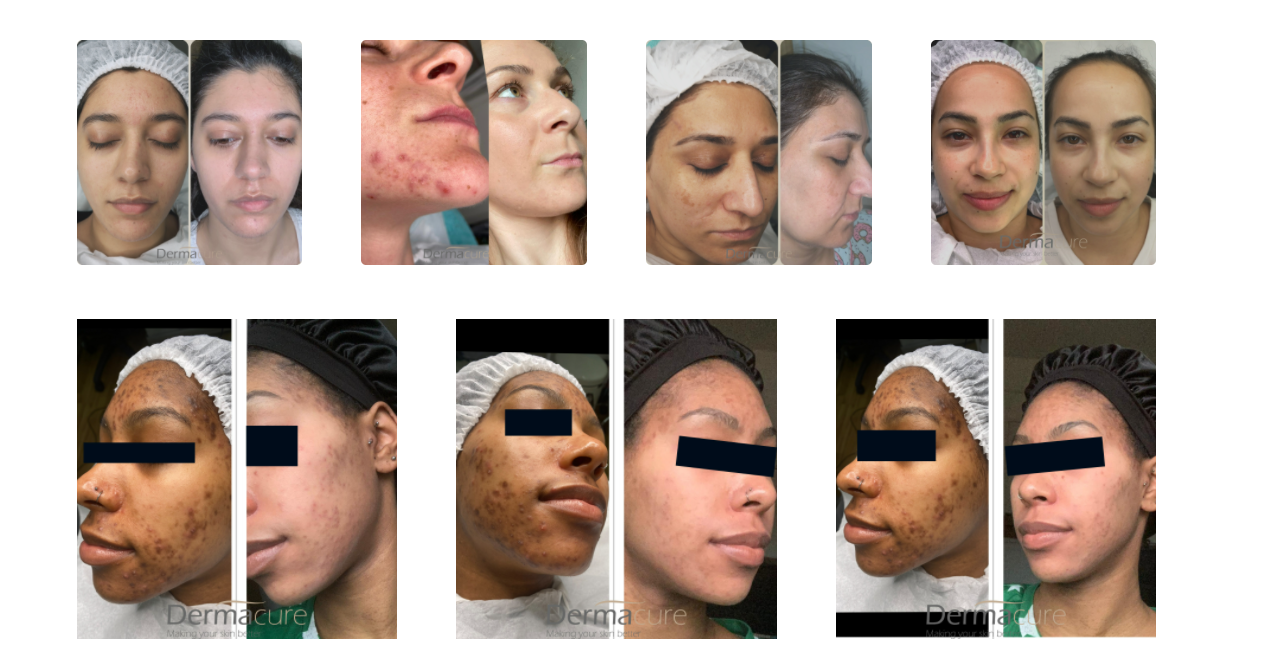
In today’s blog, we will be discussing a skin condition that affects many people! Hyperpigmentation or melanoderma, which many of us are searching for a treatment for. Hyperpigmentation refers to the excess production of melanin (skin colour). The excess production of melanin results in darker patches throughout the skin. Discolouration can occur because of various factors, which we will discuss throughout this post. Our expert aesthetics tutor and director, Eleanora, will inform you of treatments that actually treat hyperpigmentation!
So without further ado, let’s get into hyperpigmentation and how to start getting rid of it!
What is Hyperpigmentation?
Hyperpigmentation is a common skin condition characterised by patches of skin that are darker in colour compared to the surrounding skin. It occurs when there is an overproduction or accumulation of melanin, the pigment responsible for the colour of our skin, hair, and eyes.
Melanin is produced by cells called melanocytes, which are present in the epidermis, the outermost layer of the skin. Various factors, including genetics, sun exposure, hormonal changes, inflammation, and certain medications, influence melanin production and distribution.
Symptoms of Hyperpigmentation
The primary symptom of hyperpigmentation is the presence of darker patches or spots on the skin. These areas may vary in size, shape, and colour intensity, depending on the underlying cause and individual factors. Some common symptoms associated with hyperpigmentation include:
1. Darkened patches
The affected areas of the skin appear darker than the surrounding skin. The colour can range from light brown to black or even grey.
2. Symmetrical appearance
In certain types of hyperpigmentation, such as melasma, the patches often occur symmetrically on both sides of the face.
3. Discoloration on specific areas
Hyperpigmentation commonly affects areas of the skin that are frequently exposed to the sun, such as the face, neck, hands, arms, and shoulders.
4. Changes in skin texture
In some cases, hyperpigmentation may be accompanied by changes in skin texture, such as roughness, dryness, or a slightly raised or indented surface.
5. Occurrence after inflammation or injury
Post-inflammatory hyperpigmentation can develop after skin conditions like acne, eczema, or psoriasis or after a cut, burn, or other forms of skin trauma. The darkened patches usually appear where the injury or inflammation occurred.
It’s worth noting that hyperpigmentation itself is usually harmless and does not cause any physical discomfort. However, it can significantly impact a person’s self-esteem and psychological well-being.
Causes of Hyperpigmentation
Pigmentation can appear as a dark patch on the skin and may form a regular or irregular shape. You may find that your hyperpigmentation concerns are spread out or are just concentrated in one area of your skin. Many of us associate hyperpigmentation with just the face, but it can appear on the back, hands and shoulders. Hyperpigmentation can be found anywhere on the body but is more noticeable on the face, obviously.
Hyperpigmentation is a common problem which means there are many different treatments available on the market. However, before we can guide you on which treatment is best, you should understand what causes your hyperpigmentation.
Various factors trigger hyperpigmentation for individuals, and whilst everyone’s trigger might be different. These are the most common causes of hyperpigmentation :
1. Sun exposure:
Ultraviolet (UV) radiation from the sun is a major contributor to hyperpigmentation. Prolonged sun exposure can stimulate the production of melanin, leading to the formation of dark spots or sunspots on the skin.
2. Hormonal changes:
Fluctuations in hormone levels can trigger hyperpigmentation. This is commonly seen in conditions such as melasma, which often occurs during pregnancy (chloasma or “mask of pregnancy”) or as a result of hormonal contraceptive use.
3. Post-inflammatory response:
Inflammatory skin conditions, such as acne, eczema, psoriasis, or any form of skin injury (cuts, burns, or surgical wounds), can cause post-inflammatory hyperpigmentation. Melanocytes can produce excess melanin when the skin undergoes inflammation, leading to dark spots or patches.
4. Ageing:
The skin undergoes natural changes as we age, including increased melanin production in certain areas. This can result in age spots or liver spots typically seen in older individuals.
5. Genetic factors:
Some individuals may be genetically predisposed to developing hyperpigmentation. Certain ethnicities, such as those with more melanin-rich skin, are more prone to developing conditions like melasma or other hyperpigmentation.
6. Medications and chemicals:
Certain medications, such as nonsteroidal anti-inflammatory drugs (NSAIDs), antibiotics, and chemotherapeutic agents, can cause hyperpigmentation as a side effect. Additionally, exposure to certain chemicals or irritants can lead to skin discoloration.
7. Endocrine disorders:
Some endocrine disorders, like Addison’s disease or Cushing’s syndrome, can disrupt hormone levels and contribute to hyperpigmentation.
Other factors contributing to hyperpigmentation include skin trauma (repeated friction or rubbing), hormonal imbalances unrelated to pregnancy or contraceptive use, and chronic conditions like hemochromatosis (excessive iron buildup in the body).
For example, if the sun triggers your hyperpigmentation, then treatments should work alongside combatting sun exposure.
Once you understand the cause, it is then on to understanding the type of pigmentation.
Let us explore the different types of hyperpigmentation and how to treat them.
How to Treat Different Types of Hyperpigmentation
There are several types of hyperpigmentation, each with its own characteristics and underlying causes. Here are some common types and there treatment:
1. Freckles Hyperpigmentation Treatments
Freckles are a type of hyperpigmentation characterised by small, flat skin spots darker than the surrounding area. They are caused by increased melanin, the pigment responsible for skin and hair colour. Freckles are often found on sun-exposed areas, such as the face, arms, and shoulders. While freckles are generally harmless, they can be influenced by genetics and sun exposure.
How to Treat Freckles Hyperpigmentation?
The easiest type of hyperpigmentation to treat is freckles! Yup, as common as freckles are they are also a form of hyperpigmentation and sun exposure. Freckles will usually get darker in the summer and get lighter in the winter.
Hyperpigmentation Treatments for freckles include:
- Skin peels
- Lasers
- (Harmony XL PRO Laser AAFT Technology – DYE VL) – similar to IPL and is very effective.
As freckles are so superficial, we can see up to 80% reduction after the first treatment, and results can last for up to 2 years. However, it is important to remember that freckles will come back due to the body naturally producing them. You extend the length that they stay away by remaining away from the sun by wearing hats outside.
Beware that after your treatment, your freckles may appear darker until the skin starts flaking off.
2. Solar Lentigos (Age spots/sun-damaged skin) Hyperpigmentation Treatments
These are also known as age spots or liver spots. They typically appear as flat, brown or black spots on areas of the skin exposed to the sun, such as the face, hands, shoulders, and arms.
It is another common form of hyperpigmentation, with one in five people after the age of 40 experiencing sun-damaged skin.
They appear as regular shaped patches on the skin and appear on your face, hands, chest, and back. Anywhere that is exposed to the sun will experience sun damage if not protected.
How to Treat Solar Lentigos Hyperpigmentation?
Sunspots follow the same hyperpigmentation treatment route as freckles. We will also offer clients that want to treat sunspots I PIXEL laser skin resurfacing. As the clients with sun damage have older skin, laser skin resurfacing will also boost collagen production and elastin. Clients leave with firmer, tighter and hyperpigmentation free skin!
Quick Fact: Did you know, 2 hours in the sun without any form of SPF is enough time to develop hyperpigmentation?
3. Melasma Hyperpigmentation Treatment
Melasma is a common form of hyperpigmentation that usually affects women. It is characterised by symmetrical patches of brown or grey-brown discolouration on the face, particularly on the cheeks, forehead, nose, and upper lip. Hormonal changes, such as those occurring during pregnancy or while taking birth control pills, can trigger melasma.
Melasma is a condition that affects more than 50 million women around the world! One of the most common types of hyperpigmentation and a global skin condition.
It is a tricky form of hyperpigmentation to treat due to the costs and the depth. Melasma is more difficult to treat as it is more dermal than epidermal. It appears on the skin very evenly, almost like a butterfly mask. So if you have it on one side, you’ll have it on the other side.
How to Treat Melasma Hyperpigmentation?
For melasma, we recommend Cosmelan peel. Cosmelean is an acid cocktail made up of melanin inhibitors. When the pigmentation begins to lighten up, we can use laser treatments. Laser is not recommended immediately for melasma because of the light. Heat and light will trigger melasma, so laser treatments can make the hyperpigmentation worse.

Cosmelan Peel Results achieved at Dermacure Clinic
4. Post-inflammatory Hyperpigmentation Treatment
This type of hyperpigmentation occurs due to an injury or inflammation to the skin, such as acne, eczema, psoriasis, or a cut or burn. The affected area may darken temporarily or persistently after the initial skin condition has healed.
How to Treat Post-inflammatory Hyperpigmentation
Post-inflammatory hyperpigmentation is more difficult to treat than the others previously mentioned. There are also a lot of considerations for the therapist to bear in mind. For example, using a lower setting for post-inflammatory hyperpigmentation treatments. Otherwise, you can cause the skin to produce more.
PIHP occurs as a temporary pigmentation mark that follows an injury or skin inflammation such as acne!
Treatments that we recommend are:
- Q Switch Laser
- I-Pixel Laser
However, maintenance is more important! To maintain results, clients need to stick to their discussed aftercare. Dermatologists will often recommend those with PIHP creams that suppress melanin. These creams will feature ingredients such as kojic acid, hydroquinone and tranexamic acid.
As a client, it is so important to understand that if you neglect your post-treatment care, results will not last!
Take Action Against Hyperpigmentation Today
Hyperpigmentation is something that many women and men alike suffer from, through no fault of theirs. With today’s advancements, there are now many treatments on the market that can help treat those with hyperpigmentation. We hope you found this blog post useful!
